How Often Should You Change the HVAC Filter?
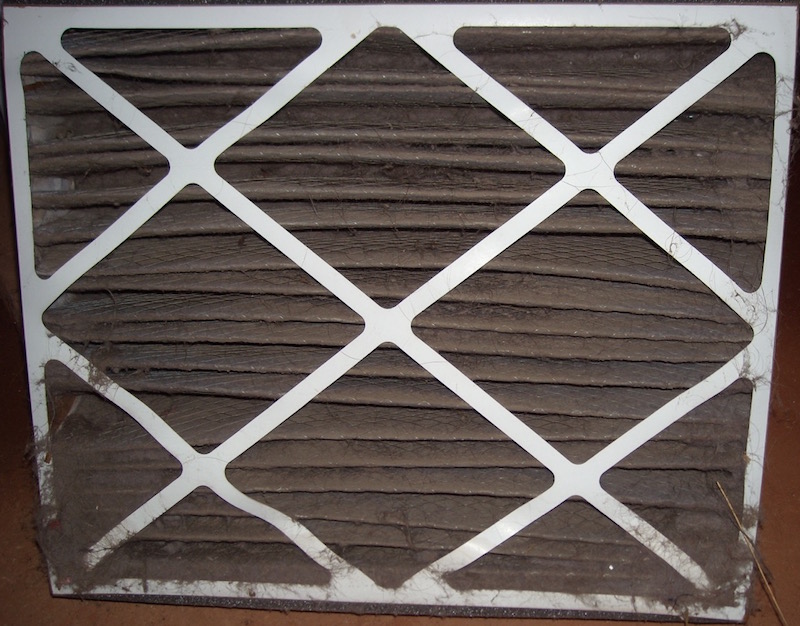
One of the topics I’ve hammered on for years is the inadequacy of using rules of thumb for sizing air conditioners. The standard one ton of air conditioning capacity for each 400 to 600 square feet of conditioned floor area just doesn’t work. We know that a load calculation based on how a particular house is likely to perform is much better than a rule of thumb. Another area where a rule of thumb dominates is in replacing the filter in your air conditioner (or heat pump or furnace). Change it every thirty days, right?
Is 30 days the answer?
When you buy the standard one inch fiberglass filters for your HVAC system, the instructions on the package usually say to change it every 30 days. This advice gets repeated dutifully by a lot of people and organizations trying to help. And the truth is, you won’t cause any problems by changing your filter every 30 days and you might even prevent some. A few years ago, I spent a day going on service calls with Phil Mutz of Moncrief Heating & Air Conditioning here in Atlanta. As you might expect, some of the problems we found were caused by low air flow due to dirty filters.
Changing the filter every 30 days is a hassle, though. In spring and fall, the filter generally won’t get as dirty because there’s not as much need for heating and cooling, so you can get by with not changing it as frequently. And in a house that doesn’t have much infiltration or duct leakage and a low level of dust overall, the filter can stay clean longer even when being used a lot (unless your return vents are in the floor).
And then there’s the issue of the type of filter. If you’ve been following this blog over the past year, you know I’m a fan of high-MERV filters that are thicker (at least two inches) because they do a much better job of cleaning the air. If you want good indoor air quality (IAQ), you need better filtration and that means a MERV-13 filter. But high-MERV filters also happen to be more expensive so changing them every 30 days is not the so good for your pocketbook.
The good news with high-MERV filters, though, is that they usually hold more dirt. There’s more surface area with thicker, pleated filters so when they capture the same amount of dirt as a standard one inch filter, the change in pressure drop isn’t as much. So how do you know when to change them? Well, if your filter looks like the one in the photo at the top of this article, you’ve waited too long. But there’s a better metric than visual inspection.
How about using the pressure drop across the filter?
I recently wrote about how to get a low pressure drop across a high-MERV filter, and the issue of when to change the filter came up in the comments. Here’s what John Semmelhack wrote there:
Our general rule is that when the pressure drop across the filter doubles from the initial, clean pressure drop, it’s probably time for a change. With big, deep filters this can take a loooooooong time, and the filters will look absolutely disgusting well before the pressure drop would indicate that it’s time for a change.
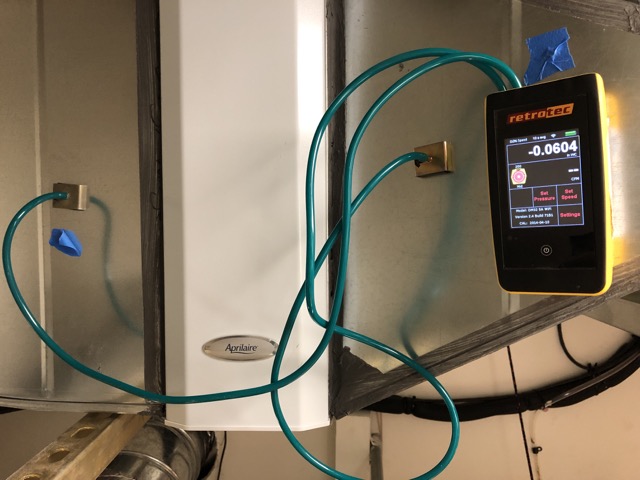
The photo above shows how to make the measurement of pressure drop. You need a hole in the return ductwork on each side of the filter. In this case I used two static pressure probes, one inserted in each hole. Each probe has a piece of hose connecting the probes to the input and reference pressure taps on the Retrotec DM32 digital manometer.* In the photo above, the pressure drop across this MERV-13 filter is a low 0.06 inches of water column (i.w.c.).
The Retrotec DM32* shown above and the TEC DG-1000* both run well over $1,000, so it doesn’t make sense to buy one unless you’re going to use it to make money. A lower cost manometer that can do the job is the Testo 510,* which is ~$150 at TruTech Tools.
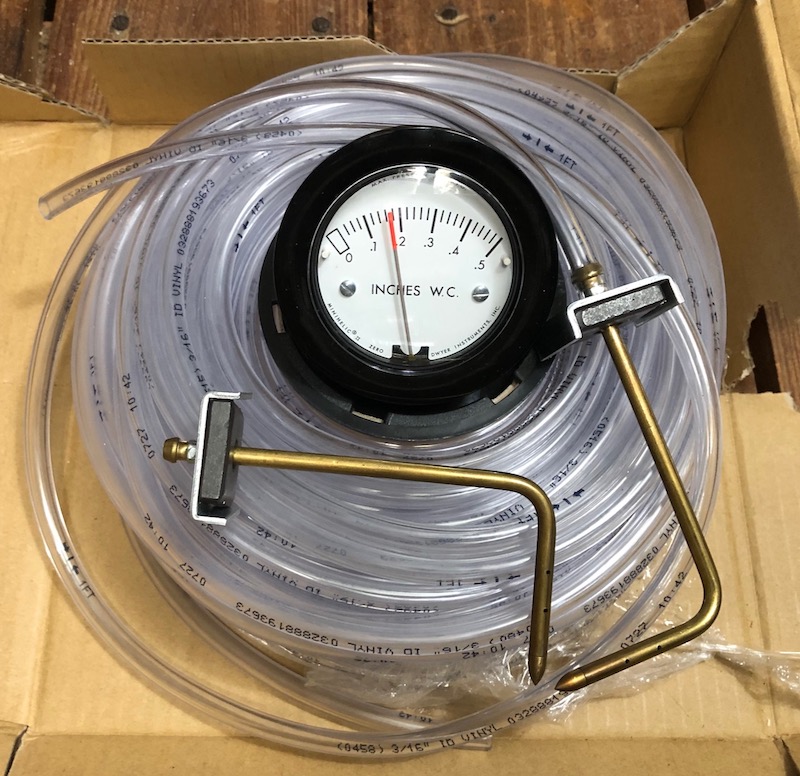
If you’re not an HVAC or home performance professional and don’t want to spring for a digital manometer, you can set up your system with a magnehelic gauge, shown in the photo above. You can get a decent magnehelic gauge made by Dwyer* for about $50. Make sure to get the lowest range they sell: 0 to 0.5 i.w.c, which is the model 2-5000-0. If you ever have a filter with a pressure drop even approaching the upper limit of that gauge, you have a problem. You’ll also need a static pressure probe* (or two) and 3/16″ inside diameter vinyl tubing,* as shown in the photo above.
What about the total system pressure?
One thing needs to be pointed out here: Waiting for your pressure drop across the filter to double will work only for a filter that’s designed properly and has a low pressure drop with a clean filter. And you also need a duct system that’s designed properly, without excessive resistance to air flow.
If you put in a MERV-13 filter and the pressure drop across a brand new, clean filter is 0.25 i.w.c., which is not at all uncommon, you can’t let that filter load to the point where the pressure drop is 0.5 i.w.c. That would mean the pressure drop across the dirty filter by itself is equal to what’s allowed for the total external static pressure. That is, the filter has used up all the pressure that’s supposed to be used up in the drops through the whole duct system (and the air conditioner coil in the case of a furnace).
If you want to go to a performance-based method for deciding when to change the filter, you’ve got to make sure your duct system and filter design are appropriate. If they’re not, then you should fix those problems so you can get it to the point where a doubling of the filter pressure drop is your signal to change the filter.
Buy digital manometers at TruTech Tools*
Buy the Dwyer magnehelic gauge at Amazon*
Related Articles
The Path to Low Pressure Drop Across a High-MERV Filter
Do High-MERV Filters Always Reduce Air Flow?
The Unintended Consequences of High-MERV Filters
* These are affiliate links from Amazon or TruTech Tools. You pay the same price you would pay normally, but Energy Vanguard makes a small commission if you buy after using the link.
This Post Has 6 Comments
Comments are closed.

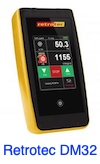
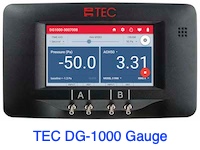

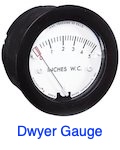
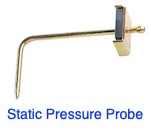
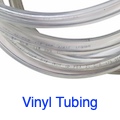
General Filters makes an
General Filters makes an inexpensive G-99 air filter gauge which can be calibrated to measure 0.1″ – 0.4″ of water column pressure:
https://www.generalaireparts.com/amfile/file/download/file_id/2168/product_id/31773/
Worth a shot if it keeps me
Worth a shot if it keeps me from buying one filter a year. Of course, I still have to go into the crawlspace once a month to check it. 🙂
Great article. Filter design
Great article. Filter design/maintenance is among the most important factors in system performance, especially for cooling. But as you point out, over doing it can be expensive, especially when using higher MERV filters.
To that end, I recommend thermostats that have a filter reminder based on run-time (hours). Many brand/models now have this feature but not all allow the user to adjust the target run-time. It takes some trial-and-error to come up with the appropriate change interval, depending on type of filter and loading rate. A manometer is the best way to figure that out.
My experience: after I
My experience: after I learned Carrier Infinity controls used change in static pressure to judge when filter needs changing, I tried to do that too. At that time you could buy a Dwyer Model 25 manometer really cheaply (the kind with red oil in a glass tube), and I connected two tubes to measure external static pressure (ESP) for the air handler. My expectation was that I would see ESP gradually rise as dirt got on the filters.
No matter how long I delayed changing the filter, could never detect a measurable increase in static pressure. Up to 2-3 years, the ESP remained constant. It was however, an easy way to tell if the system was in 1st or 2nd stage (American Standard Allegiance 18).
I was also gung-ho on getting ESP down to a good number, and adding a few new returns was one way of doing that. At this time the filters are sized at 300-400 sqin/ton, or a filter face velocity of 130-180 fpm. I understand that many home AC systems have smaller sized ductwork and filters, and might have different results. But that was how it worked for me.
Why use a proportional
Why use a proportional pressure drop, instead of an absolute one?
.1 to .2 or .25 to .35
Something I learned about
Something I learned about filters relates to the use of cold mist humidifiers. We all know how, when using hard domestic water, those humidifiers can create clouds of mineral precipitate that ends up on every horizontal surface, and rapidly clog even low $$$ filters. Distilled water is too expensive, so we just use a CM unit in the bedroom at night.
As an amusing sidelight, I thought condensate from my furnace would be a good alternative…not! It’s nasty stuff.
Doesn’t rain enough around here in a Northern NV so that’s not an option and saving AC condensate is no go as well, since we cool with overnight ventilation.
Sigh…